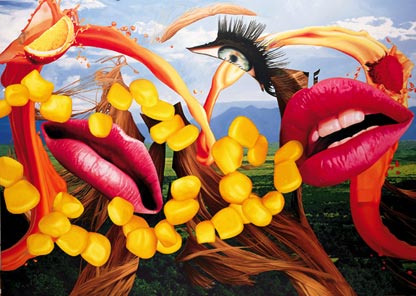 |
 |
 |
 |
  |
 |
Jeff Koons, Lips, 2000. Oil on canvas, 120 x 172 inches. Deutsche Guggenheim Berlin. T130.2000. Photo by David Heald.
 |
 |
 |
 rose to prominence in the mid-1980s as part of a generation of artists who explore the meaning of art in a media-saturated era and the attendant crisis of representation. With his stated artistic intention to "communicate with the masses," Koons draws from the visual language of advertising, marketing, and the entertainment industry. Testing the limits between popular and elite culture, his sculptural menagerie includes Plexiglas-encased Hoover vacuum cleaners, basketballs suspended in glass aquariums, and porcelain homages to Michael Jackson and the Pink Panther. In extending the lineage of Dada and Marcel Duchamp, and integrating references to Minimalism and Pop, Koons stages art as a commodity that cannot be placed within the hierarchy of conventional aesthetics. rose to prominence in the mid-1980s as part of a generation of artists who explore the meaning of art in a media-saturated era and the attendant crisis of representation. With his stated artistic intention to "communicate with the masses," Koons draws from the visual language of advertising, marketing, and the entertainment industry. Testing the limits between popular and elite culture, his sculptural menagerie includes Plexiglas-encased Hoover vacuum cleaners, basketballs suspended in glass aquariums, and porcelain homages to Michael Jackson and the Pink Panther. In extending the lineage of Dada and Marcel Duchamp, and integrating references to Minimalism and Pop, Koons stages art as a commodity that cannot be placed within the hierarchy of conventional aesthetics.
Entitled Easyfun-Ethereal, Koons's series commissioned for Deutsche Guggenheim Berlin features food, fashion, and fun. These seven large-scale paintings foreground happy-face deli sandwiches, enormous lips, spiraling roller coaster rides, and wind-swept hair all set against sublime landscapes. Working from computer-scanned reproductions taken from the media and personal photographs, Koons combines familiar yet sometimes unrelated images to create collage-like paintings rendered with photo-realist perfection. These works recall the advertising iconography and billboard-style painting technique present in James Rosenquist's paintings. Yet by comparison, Koons's work exudes a sense of excess and effervescence. Compressed into the foreground, his subjects are purposefully flat and opaque, denying any specific social critique or psychological implications. Instead, his imagery emphasizes complete and total self-gratification, celebrating adult sexual desire and allure, as well as an ever-wanting child's consumption of popular culture.
Although his imagery overflows with familiar icons from everyday life, the artist clarified his intentions when—in reference to an earlier group of paintings also called Easyfun (1999), from which the series on view derives—Koons said in an interview: "I've worked with things that are sometimes labeled as kitsch; but I've never had an interest in kitsch per se. I always try to give viewers self-confidence—a foundation within themselves. For me, my work is about the viewer more than anything else." Koons's work is infused with elements of the Baroque; the swirling, uplifting imagery is designed to entice, to create optimism, and to instill "confidence and security."
Koons's new brand of Pop painting cleverly engages other art-historical references, in particular Surrealism and Abstract Expressionism. Lips, for example, is a disjunctive free-floating fantasy. The disembodied succulent lips and drifting lush-lashed singular eye recall the work of Salvador Dalí, Max Ernst, and René Magritte, while the surrounding streams and splashes of juice echo the abstractions of Jackson Pollock, to whom Koons makes a direct reference in another painting titled Blue Poles. His fusion of Pop representations with Surrealist and abstract overtones creates a hybrid of fun and fantasy, forming a body of work that depicts gravity-defying forms of dreamlike pleasure. In creating this series Easyfun-Ethereal, Koons engages both past and present, employing the new technology of computer imagery while recalling various movements from the history of art.
|
 |
|
|